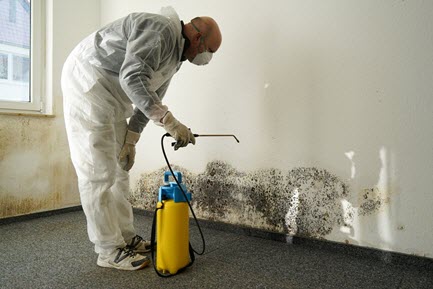
Written by Kayla Jane Barrie Updated on Nov 21, 2025 7 mins read

Mould is a common enemy of homeowners in Ontario. It’s not something you want to see. It’s a common result of water damage from flooding, leaks, and other issues. Growth can also happen over time in areas where water and moisture are present.
In your home, it poses a serious health risk and it can do significant damage which can be extremely expensive to repair and impact your home insurance in Ontario. As a homeowner, it’s vital to understand how to improve indoor air quality to keep your family and visitors healthy.
For these reasons, you need to care about mould, know how to deal with it and make sure you understand how your coverage relates to mould damage.
Mould is a common term for any fungus that grows on damp materials. It is related to yeast, mushrooms, and other fungi. Even though it is a natural part of the earth, it often grows inside buildings and can be a health hazard when growing inside.
It can produce a potentially harmful substance called mycotoxins, which creates a variety of allergic responses or hypersensitivity diseases in people.
It can also cause physical damage to structures because mould can lead to rotting wood components of buildings, tiles, drywall, and carpets. Mould can also contribute to sick building syndrome, an illness where occupants experience symptoms of illness while inside, but the direct cause is not specified.
Where there are leaks, pooling water, and dampness, mould is never too far behind.
While mould from severe water accidents such as sewer backup or a burst pipe is commonly covered, it’s not uncommon for mould-related insurance claims to be rejected if growth has been present for some time. Insurers view this as neglecting home maintenance and it will not be insured.
Depending on your policy, you may have coverage limits related to water and mould protection. If the repairs go beyond your policy, you will have to pay out of pocket, after the insurance deductible is paid.
Since mould remediation can be expensive, it’s important to address leaks and mould damage as soon as an issue is identified. As soon as you experience damage, call your insurer and have it cleaned up by a professional. The longer you leave the issue, the more it will spread and the more difficult it will be to clean up.
Make sure you are aware of what is not covered in your policy and consider purchasing additional coverage to top up protection against water issues. In some cases, you may be able to purchase a mould rider to supplement your current coverage. Talk with a ThinkInsure expert about your options.
If you rent, not only is it crucial to have tenant insurance, but it’s important to speak with your landlord about any mould problems. Most policies will cover it, but only if it results from an accident caused by a covered peril. Similar to being a homeowner, mould from poor maintenance or negligence will not be covered by insurers.
Insurance will not cover mould caused by negligence – but if you have a named peril in your policy that is covered, your insurer will help with the removal of it in your home.
For example, it will not cover mould that grows in your basement over a number of years because of a foundation crack that was not repaired. On the other side, if there was a storm that caused water to enter your home, and caused mould on the wall and under the carpet, you may be covered.
Depending on the type of claim, the cause of mould damage, and your insurer, you may see an increase in your premium. The more claims you submit, the more your rate is going to increase, no matter what the claim is for. Always evaluate the situation and associated costs to decide if it is worth making a home insurance claim.
Mould can be extremely hazardous to your health. Elevated levels of mould in your home can affect anyone who is exposed to it. If ingested, it can make you seriously ill, and in extreme cases, could cause death if you have an allergy or pre-existing medical condition.
Signs that mould or mildew may be present in your home include:
Some people are at a greater risk of the health effects of mould. Infants, the elderly, and people with respiratory issues are more sensitive to it. Some airborne moulds can cause lung infections and infect people with weakened immune systems.
See your doctor if you are experiencing these symptoms, and have your home inspected by a professional for the presence of it.
Mould grows just about anywhere. It can grow on almost any surface indoors and outdoors. However, there are common areas that you should check:
There is a very good chance you will have mould if you don’t properly clean up damage from water. Here are the ways you can identify its presence of it in your home:
Not all mould is simple to find, but if you pay attention to any visible signs or odours, you can catch the problem early.
While you won’t be able to completely mould proof your home, there are some proactive steps you can take to help prevent it from growing:
Mould cleanup is something that you need to take seriously. Whether mould is a result of flood or a sewer backup insurance claim, how you approach cleanup will depend on several factors.
The first thing you need to do if you find mould is to determine the size of the issue. You can clean up small areas of mould; however, a larger presence should be handled by a professional mould remediation company.
The US Environmental Protection Agency explains:
The US Environmental Protection Agency explains:
Who should do the cleanup depends on a number of factors. One consideration is the size of the problem. If the mouldy area is less than approximately 10 square feet (roughly a 3 ft. by 3 ft. patch), in most cases, you can handle the job yourself.
Other things to consider when determining whether or not to use a professional are:
There are thousands of different types of mould. Some thrive inside the home more than others. To help you understand the various kinds, here are the three broad categories they can fall under:
Common moulds found inside homes include:
Any black mould that was formed after a sudden accident may be covered under home insurance. For example, if a fire occurred and the water used to put it out caused mould, your policy would likely cover it. If you notice black mould around a leaky pipe, you will likely not be covered since it was caused by negligence and could have been prevented.
Your Toronto home insurance will cover attics that are affected with mould, if it was caused by accidental water related damage. If you need to submit a claim in Toronto for mould, be sure to review your policy and hire a professional to help determine the cause of the issue.
Dealing with mould can also be an issue for condominium owners. Many building owners say they are responsible for preventing it in common areas, but residents are responsible for their units. Be sure you have mould coverage in your condo insurance so if you need to make a claim, you will have some support.
If you have mould from water-related accidents, it’s best to contact your insurer about your Ontario home insurance. They’ll be able to verify if you are covered and can help you start the process of cleaning up.
If you are not sure about the extent of your water damage insurance, contact our team today. We’d be happy to help ensure you have ample coverage to protect your home.
| Categories | Home |
|---|---|
| Tags | CondoHomeowners ClaimsHome Coverage |
Read our insurance blog to get helpful tips, information and news.
Has your car been totalled in an accident? Is your car a write off? Learn about vehicle write offs for a total loss insurance claim.
Get the facts on Toronto's auto theft problem. We break down the data, reveal the most-stolen vehicles (including the Honda CR-V and Lexus RX 350), and show which neighbourhoods are most affected.
Dive into the world of auto theft with our blog on the most stolen cars in Canada. See the most stolen cars across Canada, including provincial lists for Ontario and Quebec, and learn how high-risk models can affect your car insurance premiums.
Drive safe this winter! Check out these tips for driving in snowy and icy conditions in Ontario. Get other helpful info and FAQs on winter driving.